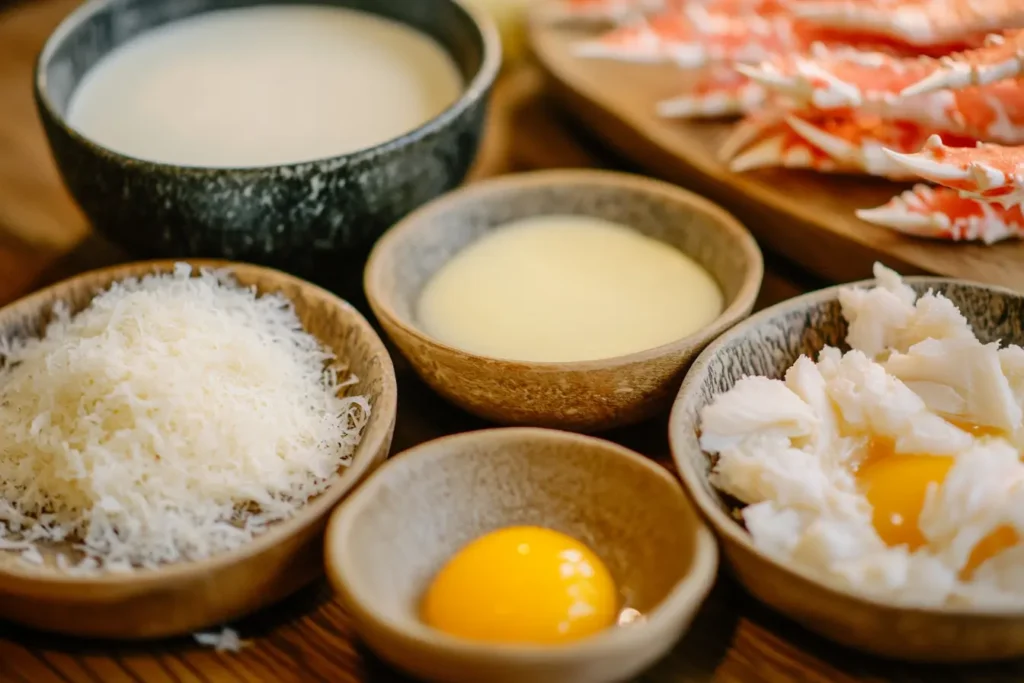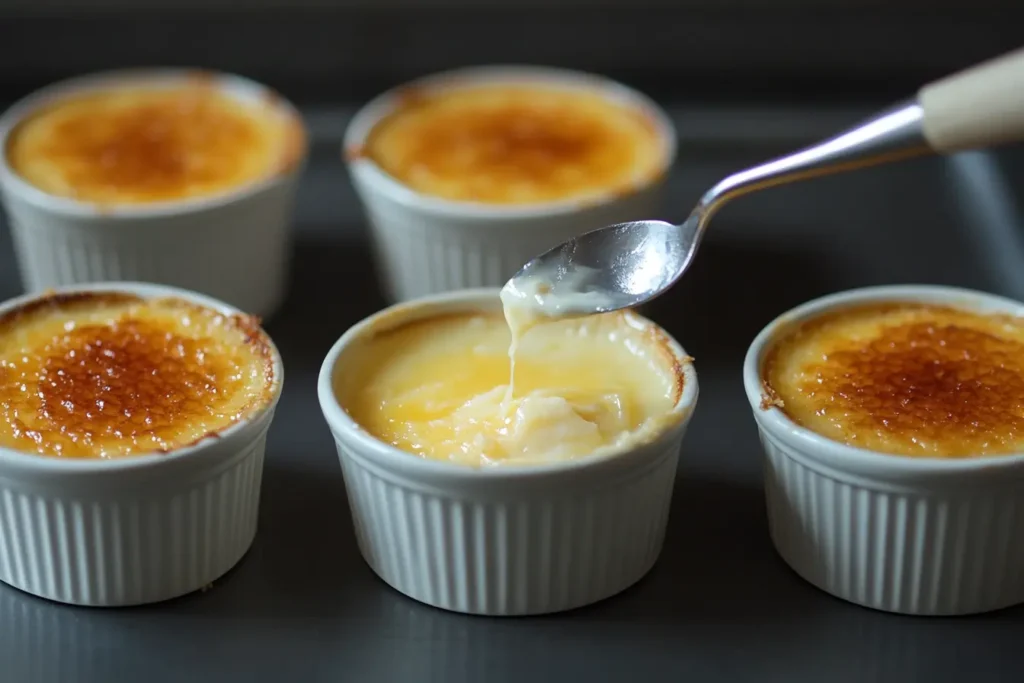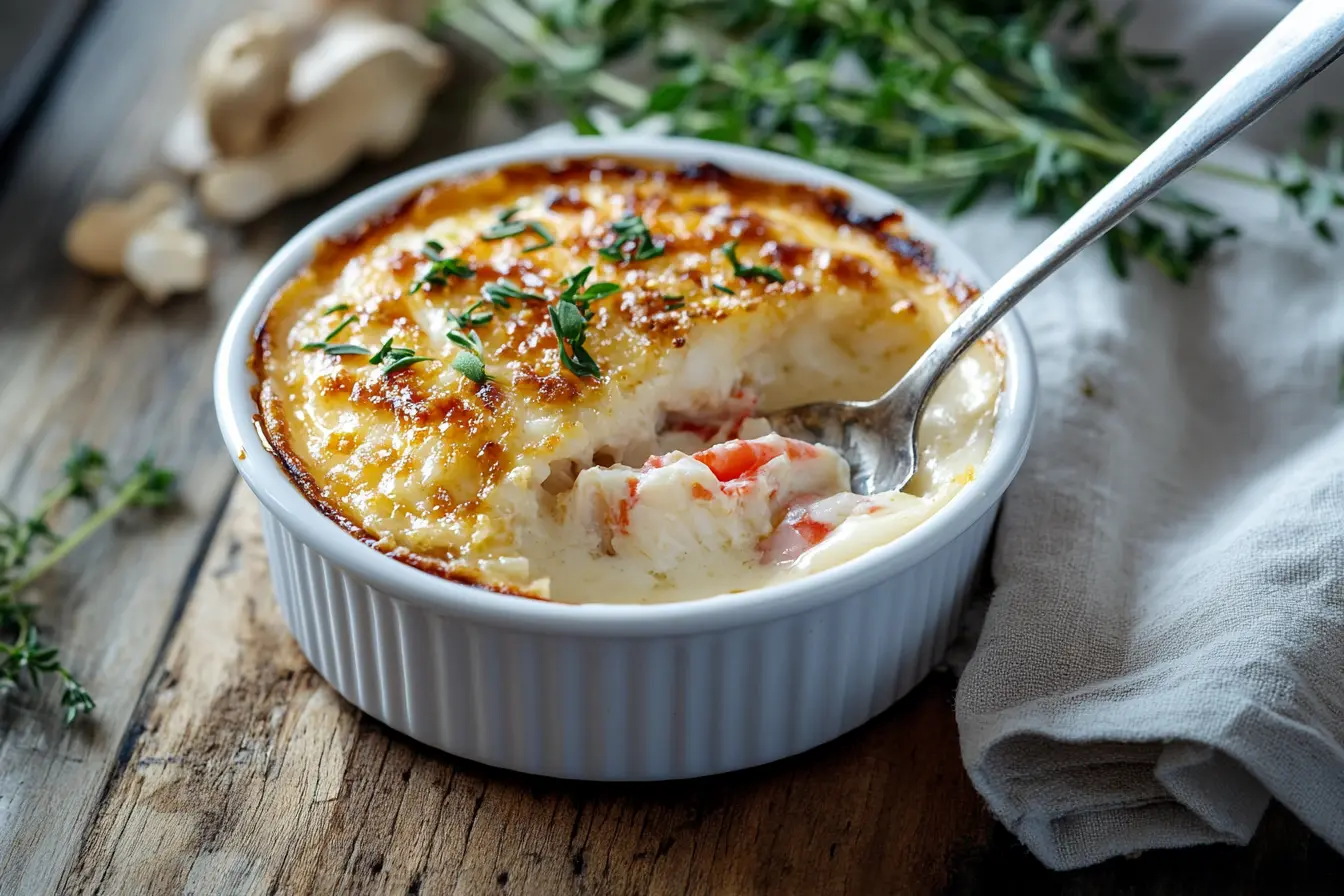Introduction
Crème brûlée is typically a sweet, vanilla-infused custard topped with a crispy, caramelized sugar crust. But what if you could take that silky-smooth texture and crunchy top and turn it into a savory seafood delight? Enter the crab brulee recipe—a luxurious, umami-rich dish that combines delicate crab meat, creamy custard, and a crisp, golden topping.
This unique dish blends classic French techniques with bold seafood flavors, making it an excellent choice for appetizers, gourmet dinners, or upscale brunch menus. Whether you’re a seasoned home chef or a curious foodie, this guide will walk you through everything you need to know about making the perfect crab brulee.
In this article, we’ll explore:
- The origins and popularity of crab brulee.
- The best ingredients for achieving an incredible balance of flavor.
- Step-by-step instructions to help you master the dish.
- Troubleshooting tips and variations for a customized experience.
Now, let’s dive into what makes this dish so special.
What Is Crab Brulee?
A Unique Fusion of Sweet and Savory
At first, the idea of a savory crème brulee might sound unusual. After all, most people associate brulee with sweet vanilla custard and caramelized sugar. However, when you swap out the sugar for rich crab meat, heavy cream, eggs, and a hint of parmesan, you get something truly special.
So, what makes a crab brulee recipe stand out?
- Creamy and decadent texture – Just like classic crème brulee, this dish has a smooth, velvety custard.
- Delicate yet bold seafood flavors – The natural sweetness of fresh crab pairs beautifully with cream and eggs.
- Crispy brulee topping – Instead of sugar, this dish is topped with parmesan, panko, or buttered breadcrumbs, torched to perfection.
The combination of rich custard and a crisp top layer creates an irresistible contrast in textures, making every bite an explosion of flavor.
Origins and Popularity of Crab Brulee
The crab brulee recipe is a modern gourmet creation, inspired by the traditional French crème brulee but adapted for seafood lovers. While its exact origins are unclear, this dish has gained popularity in:
- Fine dining restaurants, where chefs love experimenting with classic techniques.
- Upscale seafood bistros, where fresh crab is a staple ingredient.
- Home kitchens, where adventurous cooks seek new and exciting ways to elevate their meals.
Many chefs compare crab brulee to a savory custard dish, such as crab soufflé or seafood flan, but its bruleed topping gives it a one-of-a-kind texture and depth.
If you love rich, creamy seafood dishes and enjoy playing with contrasting flavors, crab brulee is a must-try recipe.
Essential Ingredients for a Perfect Crab Brulee
A great crab brulee recipe starts with high-quality ingredients that create a smooth, creamy custard while letting the delicate crab flavor shine. Choosing the right components ensures a perfect balance between savory and rich flavors.
Choosing the Right Crab Meat
The type of crab meat you use will have a major impact on the texture and flavor of your crab brulee recipe.
- Lump Crab Meat: This is the best choice because it offers large, tender pieces with a naturally sweet taste.
- Claw Meat: A more affordable option, claw meat has a stronger, slightly briny flavor, which works well if you want a bolder seafood taste.
- Fresh vs. Canned Crab: Fresh crab provides the best texture and taste, but high-quality canned crab can be used if drained properly.
No matter which type you choose, always check for shell fragments and pat the crab meat dry before using it in the custard.
Key Ingredients That Enhance the Flavor
Beyond crab, a few essential ingredients help create the creamy, savory, and slightly smoky notes that make this dish stand out.
- Heavy Cream & Egg Yolks: These two ingredients create the rich, velvety custard base that holds the crab together.
- Parmesan, Gruyère, or Goat Cheese: Aged cheeses like parmesan or gruyère add depth and nuttiness, while goat cheese introduces a slight tang.
- Shallots & Garlic: These aromatics bring out the natural sweetness of the crab and add a layer of complexity.
- Cayenne Pepper or Smoked Paprika: A hint of spice enhances the savory notes without overpowering the delicate crab flavor.
- Chives or Tarragon: Fresh herbs provide a bright contrast to the richness of the dish.
When combined correctly, these ingredients result in a luxurious, flavorful custard that pairs beautifully with the caramelized topping.

Step-by-Step Guide to Making Crab brulee
Now that we’ve covered the key ingredients, let’s walk through the step-by-step process of making a perfect crab brulee recipe.
Preparing the Crab Mixture
Before assembling the brulee, you need to create a well-seasoned crab filling:
- Sauté Aromatics: In a pan over medium heat, cook the shallots and garlic in a small amount of butter until soft and fragrant.
- Mix the Crab & Cheese: In a bowl, combine the crab meat, grated cheese, and sautéed aromatics. Season with a pinch of salt, black pepper, and cayenne for a bit of heat.
- Whisk the Custard Base: In a separate bowl, whisk together egg yolks and heavy cream until smooth. Slowly mix in the crab mixture, ensuring everything is evenly distributed.
At this stage, the mixture should be thick, creamy, and ready for baking.
Assembling and Baking Crab Brulee
Once the filling is prepared, it’s time to bake the custard to perfection:
- Preheat the Oven: Set the oven to 300°F (150°C).
- Use a Bain-Marie: Place the ramekins in a baking dish and fill the dish with hot water halfway up the sides of the ramekins. This helps the custard bake evenly and prevents curdling.
- Bake Slowly: Bake for 30–35 minutes, or until the edges are set but the center still jiggles slightly.
- Cool Completely: Remove from the oven and let the brulees cool at room temperature before refrigerating for at least 2 hours.
This step ensures the custard sets properly, giving you that silky, melt-in-your-mouth texture.

Perfecting the Caramelized Topping
One of the defining features of any brulee recipe is its signature caramelized topping. In a crab brûlée recipe, the classic sugar crust is replaced with a savory, golden-brown layer that adds crunch and depth of flavor. Let’s explore how to achieve the perfect brûléed top.
Choosing the Best Topping Ingredients
Unlike traditional crème brulee, which uses sugar for caramelization, a crab brulee recipe relies on savory elements to achieve a crispy, golden crust. Here are some of the best topping options:
- Parmesan or Gruyère Cheese: These cheeses melt beautifully and form a crisp, golden crust when torched.
- Panko Breadcrumbs: Adds an extra crunch while keeping the topping light and airy.
- Brown Butter Crumbs: A luxurious option that deepens the nutty flavor of the dish.
- Flavored Salts: Smoked or truffle salt can elevate the richness of the crab and create a more gourmet experience.
Choosing the right topping depends on your personal preference—for a rich and crispy bite, a combination of parmesan and panko is an excellent choice.
Techniques for Caramelization
Once the crab brulee custard is set, it’s time to create that irresistible crust. There are two primary methods to achieve the perfect brulee effect:
1. Using a Kitchen Torch (Best Method)
A culinary torch provides even heat control, allowing you to brown the topping without overcooking the custard. Here’s how:
- Sprinkle a thin layer of grated cheese and panko breadcrumbs over the chilled brulee.
- Hold the torch 2–3 inches away from the surface.
- Move in a circular motion, ensuring the heat is evenly distributed.
- Stop once the topping turns golden brown and crisp.
2. Using the Oven Broiler
If you don’t have a torch, the broiler method works as an alternative:
- Preheat the oven broiler on high.
- Place the ramekins on a baking sheet.
- Broil for 1–2 minutes, watching closely to prevent burning.
The broiler method is effective but can heat the custard too much, slightly altering its texture. For optimal results, a kitchen torch is highly recommended.
Now that your crab brulee has a crispy, golden topping, it’s time to ensure everything comes out perfectly by avoiding common mistakes.
Common Mistakes and How to Avoid Them
Even experienced chefs sometimes struggle with getting the perfect balance in a crab brulee recipe. Avoid these common pitfalls to ensure a smooth, creamy custard and a perfectly caramelized top.
Preventing a Runny or Overcooked Custard
A crab brulee recipe should have a silky-smooth texture, but if it turns out too runny or grainy, these factors might be to blame:
- Overbaking the Custard: If the custard bakes for too long, it can become rubbery and dense instead of creamy. Always remove it from the oven when the edges are set but the center still jiggles slightly.
- Skipping the Water Bath: A bain-marie (water bath) prevents direct heat from curdling the eggs. Without it, the custard can cook unevenly.
- Incorrect Temperature: Baking at too high a heat can lead to curdling. Stick to 300°F (150°C) for an even, gentle bake.
By following these tips, you’ll ensure a custard that is creamy, delicate, and rich in flavor.
Balancing the Sweet and Savory Flavors
One of the biggest challenges in a crab brulee recipe is getting the flavors just right. Here’s how to avoid overpowering the dish:
- Go Easy on the Salt: Since cheese, crab, and seasonings already add salinity, avoid over-salting the custard.
- Use Fresh Crab Meat: Canned crab can sometimes have a briny, overpowering taste. If using canned, rinse and pat it dry before mixing.
- Adjust the Cream-to-Crab Ratio: Too much cream can dilute the seafood flavor, while too much crab can make the custard dense. Aim for a balanced ratio of one part crab to two parts cream.
By carefully balancing ingredients, you’ll create a crab brulee recipe that’s rich yet delicate, with a flawless, creamy consistency.
Variations and Serving Suggestions
A crab brulee recipe is already a unique and indulgent dish, but with a few creative twists, you can make it even more exciting. From flavor infusions to perfect pairings, let’s explore ways to elevate this dish for any occasion.
Creative Twists on Crab Brulee
Want to take your crab brulee recipe to the next level? Try these delicious variations:
- Lobster Brûlée: Swap out crab for lobster meat to create a more luxurious and buttery flavor.
- Truffle Crab Brulee: Drizzle a few drops of truffle oil into the custard before baking for an earthy, aromatic twist.
- Spicy Cajun Crab Brulee: Add a pinch of Cajun seasoning or Old Bay for a zesty kick that complements the crab.
- Asian-Inspired Crab Brulee: Mix in a bit of wasabi or ginger for a bold, umami-packed variation.
- Smoked Crab Brulee: Use smoked paprika or liquid smoke to enhance the depth of flavor in the custard.
These variations keep the silky-smooth texture intact while adding new layers of flavor that make the dish even more special.
Best Side Dishes and Pairings
A crab brulee recipe is rich and creamy, so pairing it with light, crisp sides creates a well-balanced meal. Here are a few perfect pairings:
- Toasted Crostini or Crackers: The crunch of buttery crostini or crisp crackers pairs beautifully with the soft custard.
- Fresh Greens: A light arugula salad with lemon vinaigrette cuts through the richness of the dish.
- Pickled Vegetables: The acidity of pickled onions, capers, or gherkins balances out the creaminess.
- Chilled White Wine: A Chardonnay, Sauvignon Blanc, or Champagne complements the seafood flavors perfectly.
By pairing your crab brulee recipe with the right accompaniments, you enhance its flavors and textures, making for a memorable dining experience.
FAQs – What People Also Ask
Many people are intrigued by this savory take on crème brûlée, but they have questions about its flavors, preparation, and variations. Here are some of the most common questions about a crab brulee recipe.
What Makes Crab Brulee Different from Traditional Crème Brûlée?
Unlike traditional crème brulee, which is sweet and vanilla-based, a crab brulee recipe uses savory ingredients like crab, cheese, and aromatics to create a rich, umami-packed custard.
Can I Make Crab Brulee Without a Torch?
Yes! While a kitchen torch provides the best control over caramelization, you can also use an oven broiler. Just be sure to watch closely to prevent burning.
What’s the Best Way to Store and Reheat Crab Brulee?
For the best texture, store leftover crab brulee in the fridge in an airtight container for up to 2 days. Reheat gently in an oven at 275°F (135°C) for 5–7 minutes—avoid microwaving, as it can make the custard rubbery.
Can I Use Imitation Crab for Crab Brulee?
Technically, yes—but fresh lump crab meat is always the best choice for authentic flavor and texture. Imitation crab has a different consistency and added starches that may affect the custard.
Final Thoughts: A Gourmet Dish Worth Trying
Now that we’ve explored everything from ingredients to technique to flavor variations, you’re ready to master this incredible crab brulee recipe.
Why You Should Try This Recipe
- It’s a creative twist on a classic French dish.
- The smooth, rich custard and crisp topping create a perfect contrast in textures.
- It’s a showstopping appetizer that’s sure to impress dinner guests.
- There are endless ways to customize it with different flavors and ingredients.
If you love gourmet seafood dishes and enjoy experimenting with unique flavor pairings, this crab brulee recipe is a must-try.
Now, grab your ingredients, heat up that kitchen torch, and get ready to savor the perfect balance of creamy, crunchy, and savory goodness! 🍽️🔥
💡 Looking for more unique seafood recipes? Check out our recipe collection for more fine-dining inspiration!

